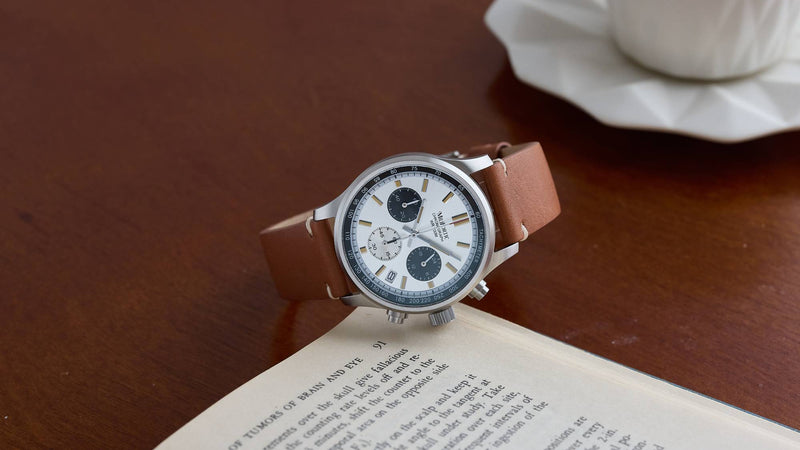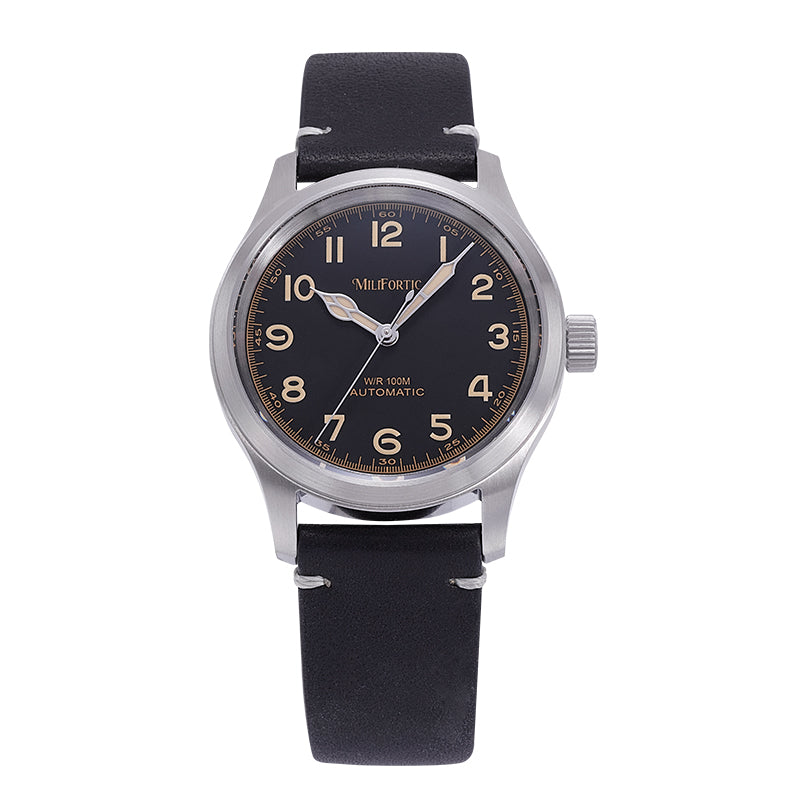
Hi there, Simon here! Today, I’m diving into a topic close to every watch enthusiast’s heart: how to read a chronograph. If you’ve ever been intrigued by those extra sub-dials on your watch but weren’t sure how to use them, this post’s for you. Let’s break it down step by step
Table of Contents
- What is a Chronograph?
- The Anatomy of a Chronograph Dial
- How to Read a Chronograph
- Chronograph Care Tips
- Milifortic R079: A Vintage Chronograph with Modern Value
- Conclusion
What is a Chronograph?
1. The Definition of a Chronograph
A chronograph is essentially a watch with a built-in stopwatch function. It’s a versatile tool that has been used for everything from aviation to motorsports and even space exploration. There are a few main types of chronographs:
- Single-Button Chronograph: Uses one button to start, stop, and reset the timer.

Hanhart Pioneer
- Double-Button Chronograph: Features two buttons, one for starting/stopping and another for resetting.
 Milifortic R079
Milifortic R079
- Flyback Double-Button Chronograph: Allows the timer to be reset and restarted instantly with a single button press.
- Split-Second Chronograph (Rattrapante): Lets you measure two separate time intervals simultaneously.

Breitling reference 766 with Venus 185
2. The Anatomy of a Chronograph Dial
Chronograph dials can vary depending on the movement and brand, but they share some common elements. Using the Milifortic R079 as our example, we’ll break down the components into two main sections: the main dial and the sub-dials. Below are the key parts:

Main Dial
- Central Seconds Hand: This is often a source of confusion for beginners. Unlike a regular watch, the central seconds hand is used for the chronograph function and doesn’t move unless you start the timer.
- Hour Hand: Indicates the standard hour.
- Minute Hand: Indicates the standard minutes.
Sub-Dials
- Minute Counter: Displays the minutes counted by the chronograph (e.g., 20, 40, 60).
- Running Seconds Sub-Dial: This shows the standard time seconds, not related to the chronograph function.
- Hour Counter (AM/PM Indicator): Helps distinguish between AM and PM, showing 24-hour time to complement the 12-hour main dial.
3. How to Read a Chronograph
1. Using the Timing Function
Let’s explore how to operate different types of chronographs. We’ll use a double-button chronograph for the demonstration.
1.1 Starting the Timer

- Double-Button Chronograph: Press the top button to start.
- Single-Button Chronograph: Press the single button to start.
- Flyback Chronograph: Press the top button to start.
1.2 Stopping the Timer
- Double-Button Chronograph: Press the top button again.
- Single-Button Chronograph: Press the single button again.
- Flyback Chronograph: Press the top button again.
1.3 Reading Sub-Dial Data

At this point, after nearly 30 seconds, the main dial seconds hand indicates 6 o'clock and the subdial minutes hand moves slightly
Each sub-dial tracks specific intervals:
- Minutes: Check the minute counter sub-dial.
- Seconds: Read the central seconds hand if the timer is running.
1.4 Resetting the Timer

- Double-Button Chronograph: Use the bottom button.
- Single-Button Chronograph: Press the same button after stopping.
- Flyback Chronograph: Timer resets and runs again as soon as the bottom button is pressed.
2. Using the Tachymeter Scale
Tachymeters are typically used to measure speed over a fixed distance.
2.1 Measuring km/h
- Start the timer as the object begins traveling.
- Stop it after 1 km. The central seconds hand will indicate the speed on the tachymeter scale.
Let's use R079 as an example, at this point there is a car ready to leave from its starting point, and it is focused on a place that is 1KM away from its starting point in a straight line.
As this car sets off, I press the chronograph timing button, and as it reaches the finish line, I press the pause button on it again.
At this time, R079 shows that the chronograph second hand has gone to the 8 o'clock position, and the number indicated is 90, so it means that the speed of this car in this interval is 90km/h.

2.2 Calculating Hourly Rates
Use the same method to measure units produced in an hour by timing one cycle of production.
Chronograph Care Tips
- Avoid leaving the chronograph running continuously to prevent unnecessary wear.
- Check water resistance, as chronographs are often less water-resistant than other watches.
- Avoid pulling the crown while timing.
Milifortic R079: A Vintage Chronograph with Modern Value
The Milifortic R079 delivers incredible value at just $106, offering features and materials typically found in mid-to-high-end watches. With a 60-minute chronograph—unlike many models that only track 30 minutes—it stands out as a functional and versatile timepiece. The retro-inspired dial design, reminiscent of classic vintage chronographs, adds timeless charm and sophistication.
Crafted with premium materials, including a 316L stainless steel case, brushed finishing, and a scratch-resistant sapphire crystal, the R079 exudes durability and refinement. Powered by the VK63 mecha-quartz movement, it ensures high-precision timekeeping while blending the reliability of quartz with the mechanical charm of a chronograph. Perfect for enthusiasts seeking a stylish, high-performance watch without breaking the bank.
The Milifortic R079 is a standout in both style and functionality, offering a unique "Pause Flyback" feature. Unlike traditional chronographs, which require you to stop the timer before resetting, the R079 allows you to reset the chronograph while it’s still running. Simply press the reset button located at the bottom, and the seconds hand will return to zero, ready to start fresh without the need to pause the timing function.
Conclusion
Chronographs are more than just stylish watches; they’re functional tools that blend precision and craftsmanship. With the Milifortic R079, you get a chronograph that’s both accessible and packed with features. So, go ahead, take the plunge, and make your timepiece work for you!



0 comments